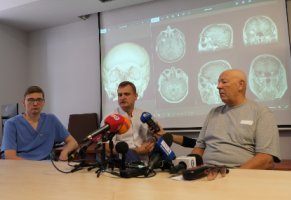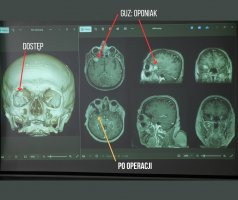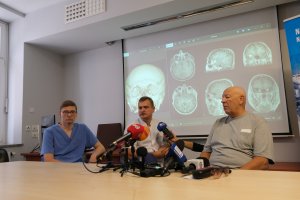Neurosurgeons removed a brain tumour through the eye socket. Performed for the first time in Poland, this new type of minimally invasive surgery is part of a trend in modern surgery aiming to reduce surgical trauma. The patient, a severely ailing 71-year-old, has only a small incision on his eyelid and is recovering quickly.
Andrzej, a 71-year-old resident of Łomża, has an extensive medical record. He has survived an acute myocardial infarction with symptoms of clinical death, and has also undergone major prostate and knee operations. When his leg and arm began to go numb a fortnight ago, he was taken to the ED with a suspected stroke. However, after detailed diagnostics, he was diagnosed with a brain tumour at the base of the middle cranial fossa. So he was referred to the Department of Neurosurgery, the only one in Podlasie that deals with brain and spine surgery.
‘Figuratively speaking, the tumour was located on the lower surface of the brain, adjacent to the base of the skull,’ explains Dr Tomasz Łysoń. ‘The base of the skull is the set of bones that forms the platform on which the brain rests. All ‘traditional’ surgical accesses to this deeply hidden area have to be extensive and therefore complex and time-consuming. And also hazardous, as important vessels and nerves run through the numerous openings in this structure.
In cases of tumours such as this patient's, none of the minimally invasive methods used to date could come into play, as it lay too far from the ‘traditional’ endoscopic access line through the nasal cavity, and was obstructed on the lateral side by important vessels and nerves and orbital structures. Therefore, it would have been necessary to make an extensive skin incision on the side of the head, remove a section of the skull base bone and then push back or lift the brain. Such manoeuvres the brain ‘does not like’ and may react with swelling, or functional damage. However, if the orbit ‘covers the tumour’, why not treat this very spatial structure as a corridor leading directly to the tumour, and by the shortest possible route? A seemingly improbable idea, given the tight filling of the orbit with its extremely sensitive contents. But recently, such a transorbital approach has been proposed in the world literature as being feasible by a team skilled in minimally invasive surgery and highly experienced in orbital surgery. In other words, a surgical team such as the one that has been operating for years at the Bialystok Department of Neurosurgery.
‘We made a small incision in the eyelid and, along the confluence of the upper and lateral orbital wall, created a narrow corridor into the middle cranial fossa, where the temporal lobe is,’ says Dr Robert Chrzanowski, who performed the operation together with Dr Robert Rutkowski.
‘The advantage of the transorbital access is that the tumour is attacked exactly from the side of its attachment to the dura and to the bone, through which its blood supply runs. Afterwards, the tumour is already as if dead, hardly bleeds and can be easily removed - importantly, without disturbing the continuity of the dura, which directly protects the sensitive brain.
The surgeons were thus able to ‘steal’ the tumour in such a way ‘that the brain does not know about it at all’, and, in addition, without causing any bleeding that would have required a blood transfusion.
- ‘This kind of surgery even realises the ideal of minimally invasive surgery, suitable for a patient with such a heavy medical burden,’ says Dr Tomasz Łysoń, who inspired his younger colleagues to perform this operation and supervised its course.
‘However, the procedure had to be performed under general anaesthesia, which, with such a risk, required the participation of an experienced neuroanaesthesia team,’ adds the Head of the Department.
The operation took place on 2 October 2024 and the patient is feeling well. He got out of bed the very second day after the operation. And all he has left is a reminder in the form of a small eyelid incision scar, no bigger than the one left after blepharoplasty - a cosmetic operation for drooping eyelids. The patient's prognosis is also good. Although there are no histopathological results yet, all indications are that it was a meningioma, a benign tumour.
Minimally invasive surgery, including endoscopic orbital surgery, is performed in literally only a few centres in the world. The Bialystok Department has specialised in this field for several years and patients from all over Poland come here. They can count on the performance of any type of necessary intervention, as the doctors here have published their own endoscopic accesses to the orbit from each side of the eyeball, and have modern equipment in the form of extensive endoscopic kits, several types of neuronavigation and, if necessary, a modern microscope and robotised exoscope. A profiled neuroanaesthetic team also works with the Department, and all patients (especially visitors) also highly praise the professional and friendly nursing care.









